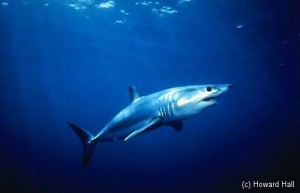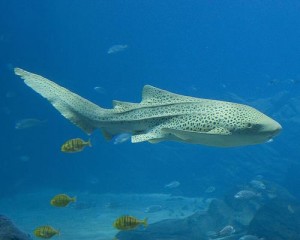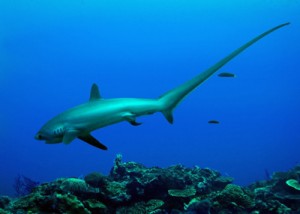Who is the (final) Shark of the Week?!?!?
The Great White Shark!!!
The Facts:
The Great White Shark is often referred to as either a white shark or “White Death”. These are the largest predatory fish in the world. They commonly grow up to be around 15 feet in length, but some have reached lengths of 20+ feet. They can weigh around 5,000 pounds. The top half of their body is a dark slate-grey color that allows them to blend in with the sea floor if you’re looking down into the water. However, they get their name from their completely white bellies, which helps them blend even more to their surroundings if you’re looking up. Much like the mako shark in its resemblance to a tuna fish, the great white shark also has a body type and tail shape similar to that of a tuna’s. This explains why they’re powerful swimmers.
These sharks often prey on sea lions, seals, small-toothed whales, turtles, and carrion. Their sheer mass and speed allow them to even breach out of the water, which looks like this:
They can propel themselves through the water at speeds of up to 15 mph. I don’t know about you, but having a 5,000 lb. animal swimming towards me at that rate would definitely not be a good day.
Cool Fact that I didn’t even know:
Scientists can calculate the age of a great white shark by counting the number of rings that shape its vertebrae, kind of like how you can tell the age of a tree by the number of rings on its trunk. From documentation and research, scientists have concluded that an average life span of a great white is about 30 years.
Great white sharks have triangular teeth measuring around 6cm each (wow!). They can have up to 300 serrated teeth in their mouth, but they’re constantly losing them. A great white shark can lose a thousand teeth in the course of its life. When biting, great whites only use 98 of their teeth (roughly). I’m not quite sure how the scientists figured that one out…
Why is the great white shark number 1?
This shark has a notoriously bad reputation. It’s nick-name is “White Death”. I don’t know how much worse it can get for the shark. This species is by far the most feared of all the other species. When people think of sharks I can guarantee that they initially think of a great white shark.
But, most people don’t understand them. Out of all the shark species, great whites are the most misunderstood. I know that sounds a bit cheesy, but it’s true. There is not enough information known about these sharks. For example, their actual population number in the world. This shark species is one of the most elusive…as well as one of the most hunted. Great white sharks are officially on the endangered list. A big part of that has to do with the movie Jaws. Jaws turned the image of great whites into monsters and then people hated them and wanted to get rid of them.
These sharks need saving. Their beautiful, massive, fearsome, and yet mysterious. Losing this creature would be a sore loss for the marine ecosystem. There’s so much we still don’t know about them. And that’s why they’re my favorite. People are afraid of them, mainly, because they don’t understand them. There’s something about them that completely captivates me.
They will forever be my number one.
I hope you all liked my shark blog 🙂 I think it was more fun for me than it was for you guys to read about them… I know this is probably asking for too much, but what I would love for all of you to get out of this blog is that sharks are wonderful. They’re mysterious and interesting. The next time you turn on Shark Week, I hope you can look at the sharks in a different light.










